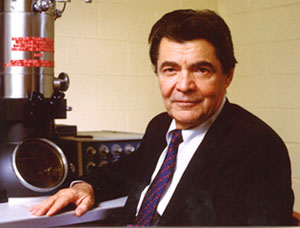Famous Romanians: Nobel prize winner George Emil Palade

 George Emil Palade was a famous Romanian cell biologist and physiologist whose work laid the foundations for modern cell biology. He won the 1974 Nobel Prize “for discoveries concerning the structural and functional organization of the cell”. He was a professor at the Rockefeller and Yale universities and founding member of the American Society for Cell Biology .
George Emil Palade was a famous Romanian cell biologist and physiologist whose work laid the foundations for modern cell biology. He won the 1974 Nobel Prize “for discoveries concerning the structural and functional organization of the cell”. He was a professor at the Rockefeller and Yale universities and founding member of the American Society for Cell Biology .
By Alexandra Fodor
George Emil Palade was born in 1912 in Iasi, eastern Romania. He attended Alexandru Hasdeu High school in Buzau before studying Medicine at the University of Bucharest in 1930. In 1940s, he received a 2-year fellowship as a visiting professor at the Rockefeller University in New York City. In 1953, he became associate member of the Rockefeller University, and in 1956, he worked there as a professor of cell biology.
In 1950s, Palade developed a method of separating cell components, known as “cell fractionation”, in which cells are broken apart and components are separated based on their density, using a centrifuge.
He discovered the ribosome, and explained the way proteins are transported out of the cell.
In 1961, he became a member of the American Academy of Sciences. He also was a member of the Institute of Medicine, the American Academy of Arts and Sciences, the Royal Belgian Academy of Medicine and the Royal Society of London.
In 1964, he gave his name to Weibel-Palade bodies (which he identified with the anatomist Ewald Weibel), components of the cells which make up the thin lining of blood vessels and the heart and which play an important role in blood coagulation.
In 1973, he moved to Yale, where he became the chairman of the new department of cell biology.
In 1974, he received the Nobel Prize for Physiology or Medicine for his contributions to the understanding of cell structure, chemistry and function (shared with Albert Claude and Christian de Duve).
Palade was a founding member of the American Society for Cell Biology (ASCB), and he served as its president between 1974 and 1975. He also worked as editor of the Journal of Biophysical and Biochemical Cytology (now Journal of Cell Biology) and at the Annual Review of Cell Biology.
He wrote important studies and works in the field of cell biology such as The fine structure of mitochondria (1952), A small particulate comportment of cytoplasm (1953), Structure and function at the cellular level (1966), Intracellular aspects of the process of protein synthesis (1975), Isolation and partial characterization of the luminal plasma lemma of microvascular endothelium from rat lungs (1992).
In 1990, he became the first dean for scientific affairs at the School of Medicine at the University of California. He retired in 2001 but remained a consultant.
In 2004, the Cellular and Molecular Medicine West Building within the University of California was renamed George Palade Laboratories.
In 2006, the University of California created the “George E. Palade Fellowship Fund”.
He has received numerous awards including Lasker Award (1966), the Gairdner Special Award (1967), the Hurwitz Prize (1970), U.S National Medal of Science (1986).
In 2007, Romanian President Traian Basescu awarded him the Romanian Star Order, the highest distinction of the Romanian state.
George Palade died in US, October 7, 2008 at the age of 95.












